Though Gibson was a company long before the arrival of the electric guitar, the model baring the Les Paul signature elevated this manufacturer to iconic status.
The Gibson Les Paul was created by the polymath inventor and put on the market way back in 1952: the dawn of the rock ‘n’ roll era.
The Gibson Les Paul has been championed by many legends of the guitar throughout the epochs, luxuriating in its thick, bottom-end, unmatched playability and superb build quality.
Read on for a definitive guide on the Gibson Les Paul, the myriad achievements of the man behind it, the difference between it and its cousin from Epiphone and one legendary example that continues to intrigue.
Compiled and edited by Dan Shaw
SHARE

The genius of Les Paul
by Riley Fitzgerald
Born Lester William Polsfuss in 1915, the artist more widely known as Les Paul is venerated as the godfather of the solid-body electric guitar and figurehead of rock ‘n’ roll. Yet the Wisconsin-born tinkerer’s achievements with the instrument pale are matched in the field of recording.
From an early age, Les Paul was possessed by a fascination with sound and technology. Herein lay his truest gift; from it sprung an ability to look past the strictures of conventional music and push outwards.
Chasing his own sonic ideal, he forever changed the trajectory of recorded music. Many of his recording innovations are not only still in use today, they’re ubiquitous.
Following the conclusion of the Second World War in 1945, Paul established his own home studio in a garage outside of his Hollywood home. A key motivator for this was a desire to remove himself from the rigid recording philosophy which dominated the minds of those working within professional studios.
He also acted to maintain the technological mystique of his recordings and to simply enjoy the comfort of working from home. After unwittingly domesticating sound recording, he partnered with then-wife Mary Ford at the onset of the ‘50s to create a string of pop successes.
Singles How High is The Moon and Vaya Con Dios would even secure the coveted positions of number one hits in the US and many of these home-cut recordings would sell millions. These commercially popular singles of the 1950s often showcased and promoted his recording techniques and technological innovations to the world.
But success is a fickle thing. The advent of rock and roll proved lethal to their tenure as pop sensations. Their hits had dramatically fallen off by 1961 and the pair divorced two years later.
Drive and Distortion – A True Visionary
For the longest period distortion was dismissed as unwanted sonic detritus. Yet prefiguring the signal processing technique that would later be known as overdrive, many early guitarists cultivated the effect by bumping up the gain on their amplifier tubes well past the point of distortion. While other contemporary guitarists may have beaten him to the punch, Les Paul was also refining his own take on the practice at an early stage.
One of the widest-reaching examples of early overdrive experimentation was his guitar contributions to Bugle Rag Call a live bebop recording captured while Paul accompanied the Nat King Cole Trio at the Los Angeles Philharmonic in 1944.
Collected on compilation Jazz at The Philharmonic, this subtly overdriven twang may not rival Jimi Hendrix’s Purple Haze in terms of sonic impact, it doesn’t even feature prominently until around the one minute thirty mark, but as an early example of overdrive, it’s every bit as influential.
During this post-war period, Paul had also realised that altering the speed of his recording device could open up new sonic possibilities. Paul quickly cottoned on the fact he could record at a lower octave, pitch and speed then speed up the final recording to create unnaturally virtuosic instrumentals. An example can be found on the breakneck noodling on 1948 single, Lover.
While Paul’s may not be the originator of phasing or flanging, he can still make a solid claim to have been one the first to expose the sonic possibilities of the effects to the public.
Paul would begin toying with phase-shifting sometime in the 1940s and was perhaps the first to employ the effect in commercial recordings. Examples of the effect can be found on 1953’s instrumental single Mammy’s Boogie and on 1955 follow-up Nuevo Laredo.
Sound on sound recording is without question Les Paul’s greatest contribution to the musical world. It’s difficult to conjure the vision, but in Paul’s time, the idea of recording the initial performance of a single instrument and then adding additional parts was nothing short of revolutionary. Beforehand artists would record a song with all members playing simultaneously, similar to how they would perform live.
While he would later move to tape, his first multi-tracked recordings were laid down on wax acetate disks. Les Paul would record an initial instrumental part and then created a secondary recording of him playing along with the first. He would then repeat the process adding as many instrumental layers as he deemed audible. Les Paul had been playing around with this painstaking process since the 1930s and the practice could require the use of up to 500 home-pressed acetate discs.
Les Paul first showed off his flashy new overdubbing and multi-tracking techniques on Lover. Employing the full ambit of his innovations in addition to his formable skills as a guitarist he applied he synthesised a signature sound. The result sounded utterly alien, his playing superhuman.
Les Paul first showed off his flashy new overdubbing and multi-tracking techniques on Lover. The result sounded utterly alien, his playing superhuman.
The chart-topping success of How High is the Moon in 1951 further advertised the multi-tracking process to the world. It was a true turning point in popular music. While rock and roll may have put a stop to Paul’s own chart success, by the middle of ‘60s The Beatles, The Beach Boys and a number of Phil Spector’s artists were realising their own creative visions with highly innovative multi-tracked albums.
While the tech Crosby had donated was only a single track or ‘mono’ machine, the first 8-track tape recorder was developed in 1953 after Paul and associate Ross Snyder pitched the idea to Ampex. Tape afforded an unprecedented ability to construct even more elaborate arrangements, including greater leeway for overdubbing and the potential for adding a staggering number of musical voices on a single track.
In 1943 Les Paul was drafted to work for the Armed Forces Radio. During his year of service he would link up with a number of influential artists including Rudy Vallee, Johnny Mercer and most importantly Bing Crosby.
After Les had established his L.A. studio following the war, Crosby would gift him a reel-to-reel audio tape recording deck in 1948. This was no small deal; magnetic tape was a new technology. In fact, Crosby himself had only acquired a pair of Ampex Model 200A recording devices after they had been liberated from the Nazi war machine. For Les Paul, tape created new worlds of possibility and sonic exploration. It expanded the fundamental parameters of music itself.
Looking to emulate an echoed shout as it bounced off the sides of mountains, Les struggled to develop an equivalent studio effect. The breakthrough came when he and a friend installed a second phonograph pickup behind the playback head on the same mono Ampex tape machine he had received from Bing Crosby. The result was a feedback loop which repeats the original recording signal.
This allowed Les Paul to play along with what had been recorded seconds before. This newfound setup allowed him to achieve the effect with ease. His application of an echo effect to the guitar parts of How High The Moon was the precursor to the slap-back sound synonymous with rockabilly guitar parts and a forerunner for the EchoPlex tape delay unit.
The mythology of rock and commercial music, in general, tends to hone in on the 1960s when remembering brilliant minds which married recording innovation to popular music. Yet if anything the work of Les Paul and his collaborators exemplify that there were equally if not more innovative creative forces at work well before.
While Les Paul passed away in 2009 aged 94, he remains a key musical figure in sound recording’s history. In a world before stomp boxes, DIY studios and even multiple tracking Les Paul intuitively pushed the possibilities of what equipment and popular music could achieve.
The Golden Age of the Gibson Les Paul
by Jack Foley
During the 1950s, the guitar experienced something of an arms race. Manufacturers were rapidly releasing and rereleasing innovative new models to compete with one another in a perpetual quest to remain ahead of the curve.
This period would produce countless iconic guitars and become known as the golden age of the electric guitar. It was in this creative crucible that the Gibson Les Paul emerged.
Les Paul was a well-known guitar innovator, having built a solid body prototype in the 1940s called ‘The Log’.
The Gibson Les Paul was made in direct response to the Fender Telecaster. The release of the Fender Telecaster in 1950 highlighted the enormous potential that solid body guitars offered.
Before the Les Paul, Gibson had mostly produced mandolins, banjos and various hollow body guitars. Gibson was eager to capitalise on the recent popularity of solid body guitars so in 1951 they began designing their own model. They approached guitarist Les Paul for design advice and to endorse their new product.
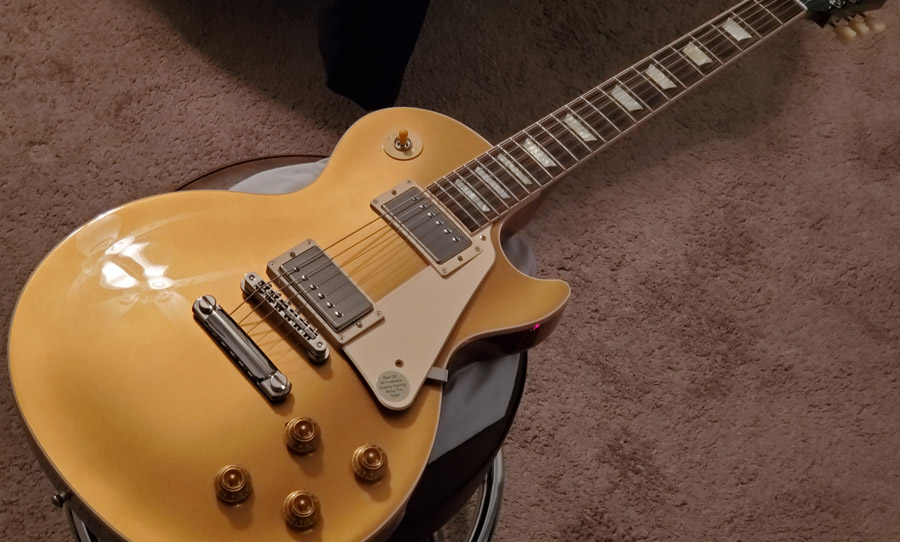
At the time Les Paul held significant clout as one of the most famous guitarists in America.
He was also a well-known guitar innovator, having built a solid body prototype in the 1940s called ‘The Log’ (Paul had actually approached Gibson with this design at the time but it was rejected).
Success Has Many Fathers
Development of the Les Paul was led by Gibson chief Ted McCarty, but exact roles in the creation of the Gibson Les Paul are strongly contested by those involved.
Les Paul himself claimed that he is responsible for many of the significant design choices, however, those who were at Gibson at the time say that Paul was presented with an already pre-designed product — he was simply asked for endorsement and permission to put his name on the headstock.
After the release of the original Gibson Les Paul Goldtop, many different Les Paul models and versions followed: the Junior, the Custom, the Special and the Standard.
Regardless of exact involvement, Les Paul’s name would become forever linked with the guitar upon its release in 1952.
The first Gibson Les Paul was named the ‘Goldtop’ and marketed as a high end, premium guitar. It featured a mahogany body, mahogany neck and rosewood fretboard. It had a striking gold finish to clearly indicate it was an upmarket product.
Despite the Les Paul’s association with humbucker pickups, the original 1952 actually featured two P90s. There were production issues early on. The original Les Paul featured a tailpiece bridge, similar to those found on hollow body guitars.

It was incorrectly installed, meaning the strings wrapped under it rather than over it. This made right-hand string dampening, or palm muting, impossible. It’s reported that this manufacturing hiccup infuriated Les Paul himself.
After the release of the original Gibson Les Paul Goldtop, many different Les Paul models and versions followed. Four different core models were released: the Junior, the Custom, the Special and the Standard. The Junior was the budget-freindly option and only contained a single P90 pickup and a flat, unmolded body.
The version that is widely regarded as the finest Les Paul is the 1957 Goldtop. The 1957 model featured a stopbar tailpiece and tune-o-matic bridge. It was also the first version to contain PAF humbucker pickups.
The new pickups, designed by Seth Lover, provide greater sound output and fuller tone. It was the inclusion of the humbucker pickups that would eventually make the Les Paul a favourite amongst rock guitarists due to the thick, heavy sustain it could produce.
Setting the Standard
In 1958 Gibson released the Les Paul Standard, called the Les Paul Sunburst for its distinct finish. It was more expensive than other Les Paul models and was marketed towards jazz players.
Although it had several improvements on previous models, such as a reduced neck profile, the Les Paul Sunburst was poorly received. There were only 1700 ever produced and it was eventually dropped from production in 1960.
Despite its underwhelming reception at the time, original Les Paul Sunbursts are some of the most in-demand vintage guitars in existence.
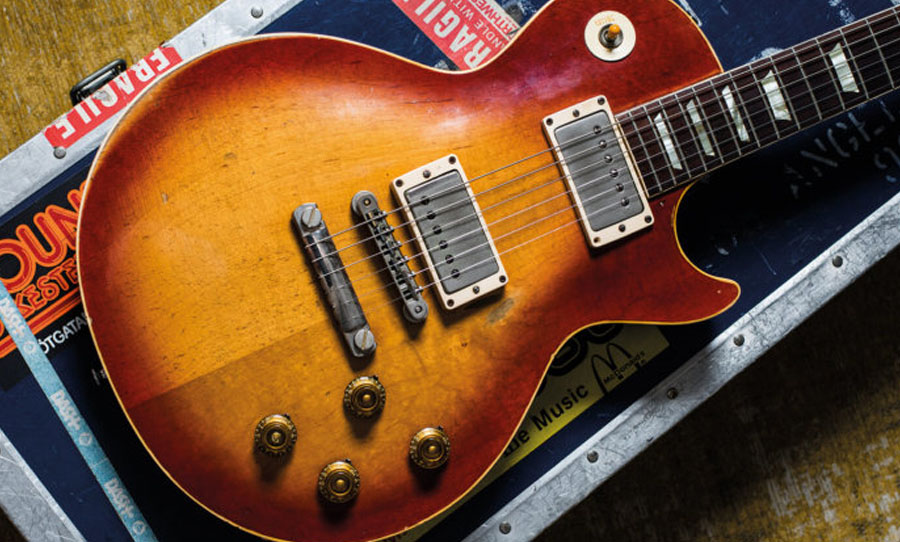
After the flurry of releases in the 1950s and the lacklustre response to the Les Paul Standard, the Les Paul fell out of fashion. Gibson ceased its production in 1961 and replaced it with the Gibson SG.
Like other iconic guitars, the Les Paul’s legend was ultimately shaped by those that played it. High profile rock guitarists such as Jimmy Page, Keith Richards and Eric Clapton all continued to play the Les Paul after its discontinuation.
This generated renewed interest in the Les Paul and led to its reintroduction in 1968. Since then Gibson has continually produced Les Pauls. Alongside the Fender Stratocaster, the Les Paul is the most recognisable silhouette in the family of electric guitars, its continued success due to its ability to adapt with technology, whilst remaining true to its original identity.
‘Greeny’: the Legend of a Special Les Paul
by Jeremy Span
“The relationship I have with this guitar is probably on par with the relationship everyone else has with this guitar,” Kirk Hammett of Metallica fame told Guitar Interactive Magazine back in 2018. Hammett is in possession of a piece of rock history. “It’s just an insane instrument.”
There are famous guitars and then there’s ‘Greeny’ — a 1959 Gibson Les Paul Standard. If guitars could talk, this one would have a lot to say having passed through the hands of some truly iconic players, beginning with the late, great Peter Green, founder of Fleetwood Mac.
When flicked into the middle position, Greeny conjures up a unique out of phase tone similar to the second position on a Stratocaster — but with a bit more oomph.
Blues legend BB King once spoke of Peter Green having “the sweetest tone I ever heard. He was the only one who gave me the cold sweats”. The sweet tone that BB King sweats over probably comes straight from the famed Les Paul that harbours a unique tonal quality.
While Les Pauls are famous for their full-bodied, resonant sound, Greeny has an extra kick thanks to the magnets in its neck pickup being wound in reverse. When flicked into the middle position, Greeny conjures up a unique out of phase tone similar to the second position on a Stratocaster — but with a bit more oomph.
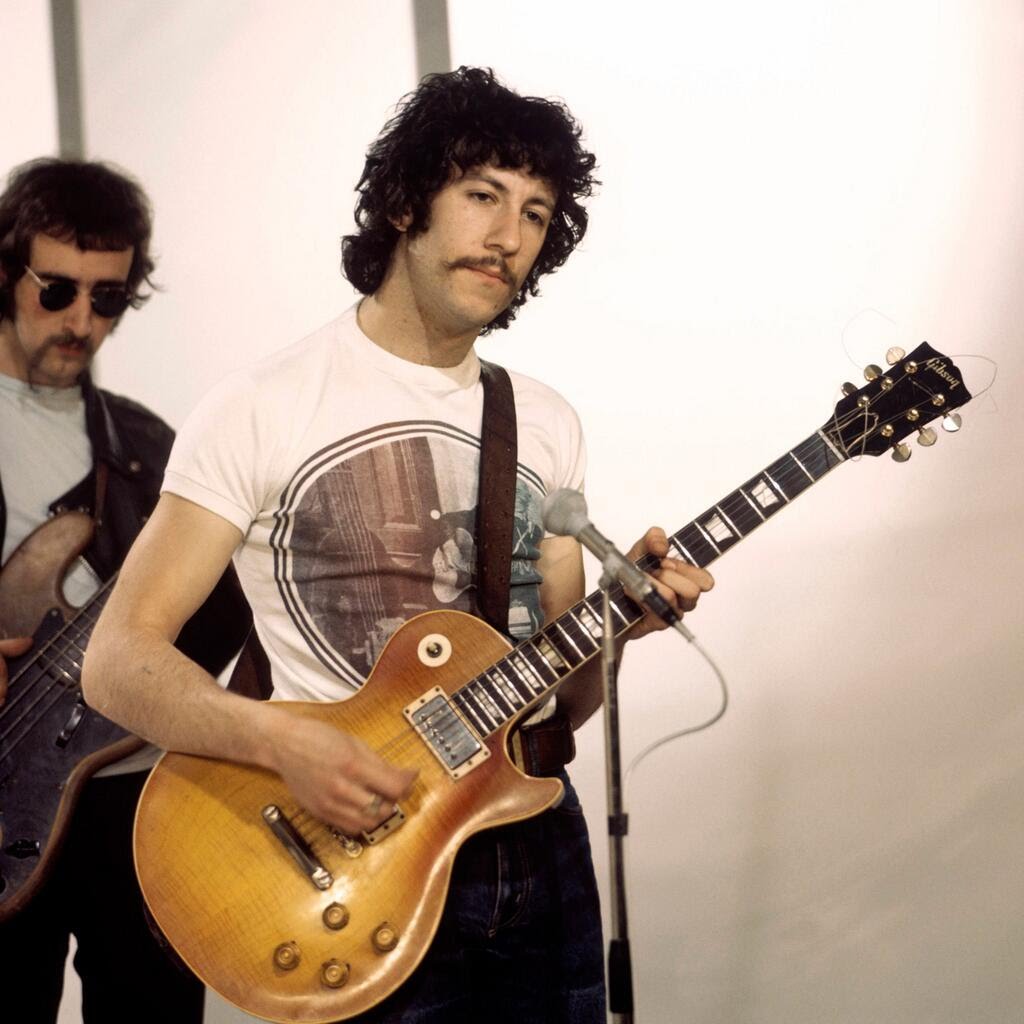
Green said in an interview that he flipped the pickup himself after taking out his neck pickup to imitate Eric Clapton, then later putting it back in the wrong way round by accident. This doesn’t account for the reversed polarity of the magnets, however.
To this day, it’s a true rock and roll myth as to if this was intentionally done by a guitar tech, Green himself, or a factory fault.
The Beginning of Greeny
Kirk Hammett, the guitar’s current owner, believes the ‘59 Les Paul was originally purchased by Peter Green sometime in 1964-1965 when he was in a band called Shotgun Express with Rod Stewart.
Yet, in 1998 when Music Radar asked Green about the purchase of the guitar, it may have been after his audition for the group he joined next that paved the way for the creation of Fleetwood Mac. Green had this say about his Les Paul:
“I stumbled across one when I was looking for something more powerful than my Harmony Meteor. I went into Selmer’s in Charing Cross Road and tried one. It was only £110, and it sounded lovely and the colour was really good. But the neck was like a tree trunk…”
The Greeny Les Paul appears on a number of recordings from Fleetwood Mac’s self-titled debut album in 1968, to Green’s last with the band, Then Play On, in 1970.
The Eric that Green mentions is Eric Clapton of course, whom Green idolised. Green dared to replace God himself by filling in for Clapton after his exit from John Mayall and the Bluesbreakers. Green had aggressively pestered Mayall to employ him, often turning up at gigs and shouting from the audience that he was much better than whoever was playing that night.
He recorded one album with the Bluesbreakers, A Hard Road, which featured this 1959 Gibson Les Paul extensively. Green opted for high output, heavy rock amps like the Marshall JTM45 head through VOX and Orange cabinets.
When Green left the Bluesbreakers, he took Mayall’s rhythm section with him. Alongside Mick Fleetwood and John McVie, Green formed Fleetwood Mac. The Greeny Les Paul appears on a number of recordings from Fleetwood Mac’s self-titled debut album in 1968, to Green’s last with the band, Then Play On, in 1970.
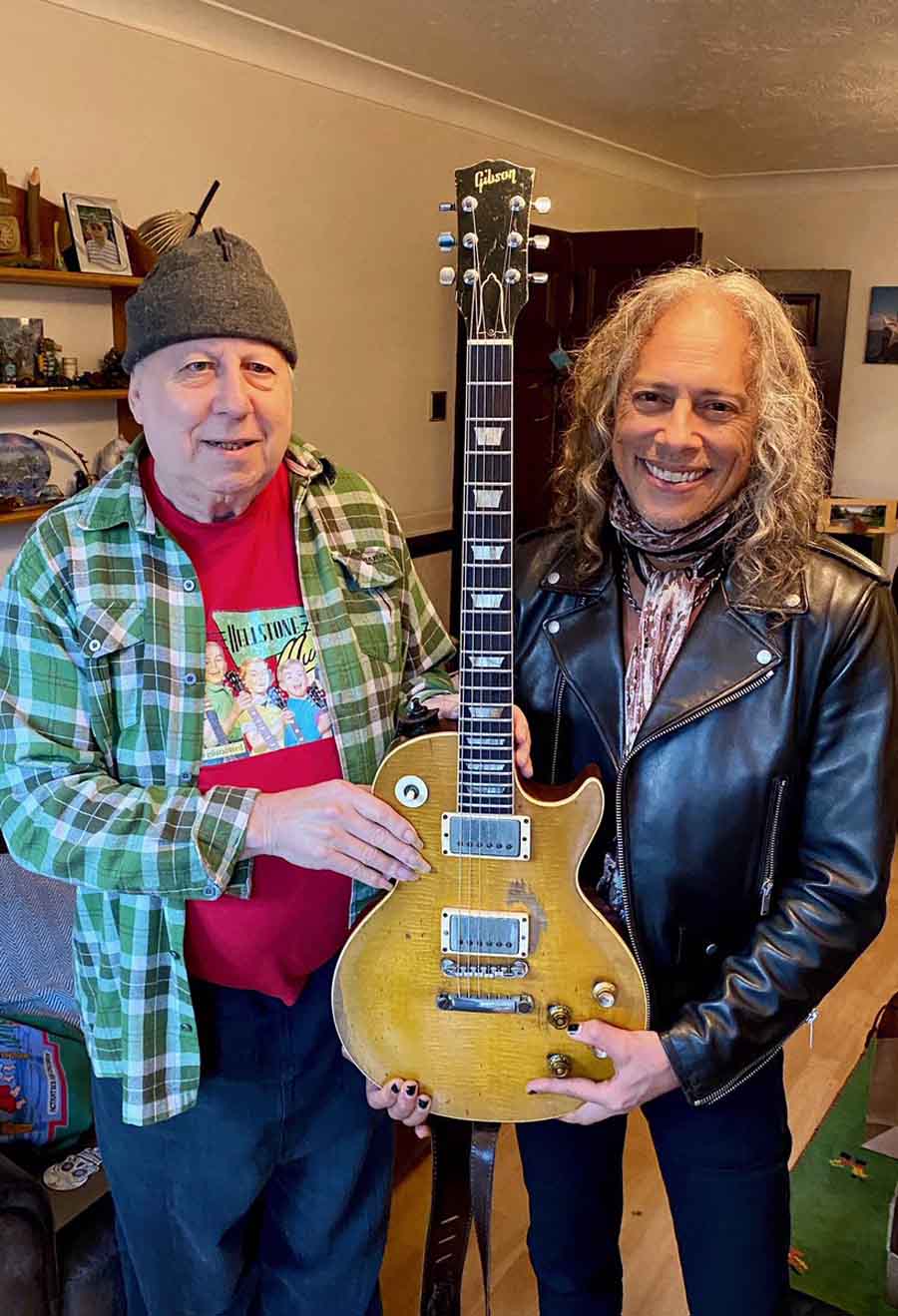
You can hear Greeny’s distinct voice on songs like Black Magic Woman, Oh Well and The Green Manalishi (With The Two-Pronged Crown). In an interview for Guitar Player Magazine in 2004, Green reflected on his iconic Les Paul:
“Actually, buying a Les Paul is one of my biggest regrets. I should have left that to Eric Clapton. I sort of overshadowed his breakthrough. But my Les Paul was a fabulous guitar. I wish I could get it back today. When you’ve got something really perfect, you don’t realize it at the time”
From One Blues Man to Another
The perfect something that Green later pined for was snatched up by another blues shredder, Gary Moore. Moore first met Green in 1970, when his band Skid Row supported Fleetwood Mac.
They spent some time talking in a hotel room one night on tour and became friends. Moore sold his SG in 1974 to buy Peter Green’s famed axe. Here’s Moore’s account of how he acquired the Les Paul from Green:
Moore went on to use the guitar for the next three decades. He played it during his stint with Thin Lizzy that saw him tour with the group and record a handful of songs. Moore continued to use Greeny on solo recordings like Parisienne Walkways and the album Blues for Greeny — a tribute album to Peter Green.
Kirk Hammett also explained in his extensive interview with Guitar Interactive Magazine that a lot of the tone of the guitar also comes from the neck itself. It was cracked while in Gary Moore’s boot when he got rear-ended.
Hammett enthused, “those out there that don’t know, whenever you break a neck on a Les Paul and then you get it repaired and plug it in… always sounds better – ALWAYS SOUNDS BETTER!”
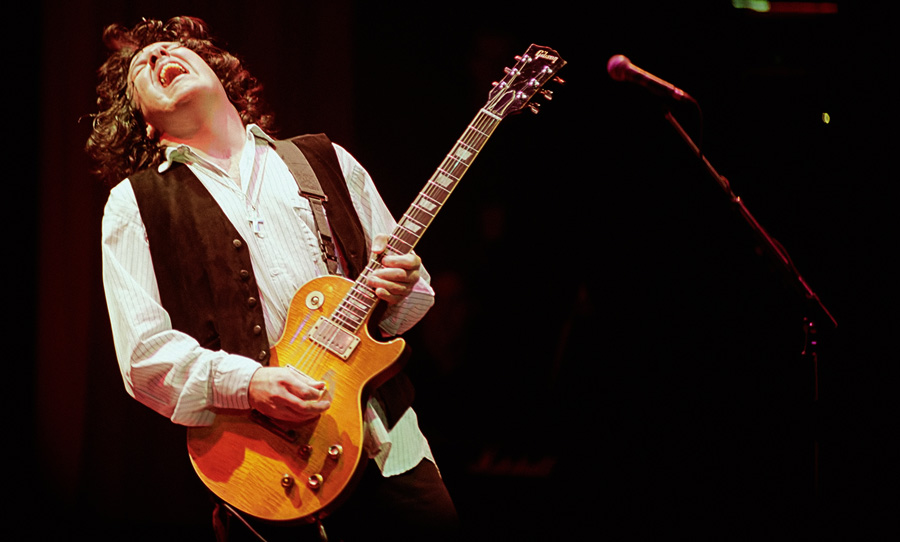
When the neck was repaired in the early ‘80s by Jol Dantzig of Hamer Guitars, the discovery was made that the neck pickup was wound in reverse — he’s on record that it was never a case of simply flipping the pickup because the pickup’s internals looked undisturbed. He believes it was a mistake made in the factory.
By the early 2000s, Moore had lost money from a copyright lawsuit and a broken hand prevented him from touring anymore. He was unable to get back residuals from cancelled shows and was forced to sell his prized possession, Greeny. When he was interviewed in 2007 for Vintage Guitar Magazine, Moore was asked if it was a difficult decision to let go of the famous guitar:
“I ended up with debt. So it was a financial thing. And that was the quickest way to do anything about it. I mean, why would I want to sell it? That guitar was played by Jimi Hendrix and Jeff Beck! Rory Gallagher played it! I played it! It was a very special instrument.”
Greeny Lives On
Greeny was sold in 2006 for a price between $750,000 and $1.2 million according to various reports. It was purchased by Phil Winfield at Maverick Music and was later put up for sale for $2 million. And then in 2014, Kirk Hammett got a call from vintage guitar collector Richard Henry while in the UK.
“I have a guitar for you.” Hammett recounts, sceptical at first. Hammett was won over when Henry brought the guitar round with a small Marshall Combo. There was no master volume on the amp, so Hammett had to crank it up in his hotel room, finding that sweet spot.
From the first chord, he was blown away “Woah, full!” Hammett recalls to Guitar Interactive Magazine. Inspecting the guitar, he could see Gary Moore’s scratch marks from where he would rest his fingers when he played. “It’s a really inspiring instrument I have to say.”

Hammett doesn’t want to see the guitar retired just yet and used it on Metallica’s 2016 album Hardwired to Self-Destruct. On tour, Hammett enlists Greeny mainly for ballads because the neck pickup has a nice clean tone to his preference, but with the flick of a switch, it roars into life.
On the podcast Let There Be Talk, Hammett narrated an encounter with Peter Green himself where he reunited the legend with his signature instrument.
“I said to Peter, ‘Hey man, I have a friend of yours in this bag.’ And I pulled it out, I showed it to him, and he said, ‘That’s not my guitar,’ which is his stock answer whenever he’s asked about Greeny. And the reason why he said that is because he doesn’t see the red in the finish. So, he says, ‘Oh, that’s not the guitar, my guitar was red.’ His friend who was just sitting across the room says, ‘He knows that’s his guitar.”
The Gibson Les Paul vs. the Epiphone Les Paul
by Luka Osborne
Nothing screams rock quite like a Gibson Les Paul. In fact, you could say it wails. From Jimmy Page to Slash, the guitar has been instrumental in shaping the sounds of rock and popular music since its release in 1953.
But when it comes to Les Pauls, there are a lot of options and one of the biggest decisions a prospective buyer has to make is weighing up the differences between the Epiphone Les Paul vs Gibson Les Paul.
Gibsons cost a lot and Epiphones are seen as an entry level alternative. So is a Gibson worth it? And does Epiphone provide a viable alternative?
No doubt a Gibson costs a lot of money and to many, Epiphone is generally seen as the more entry-level axe. But is a Gibson really worth it? And does Epiphone provide a viable alternative?
Gibson and Epiphone are both amongst the oldest of all guitar brands and for a good stint of their history, the two were staunch competitors. A little-known fun fact is that Les Paul himself created his prototype design, ‘The Log’ after hours in Epiphone’s New York plant. He then went on to work on his design with Gibson in 1951, before the famed guitar’s release two years later.
In 1957 Gibson won the duel between the two guitar giants and bought out Epiphone with the intention of broadening distribution and expanding overseas. Gibson actually used the same parts and the same factory for Epiphone guitars until the 1970s, when manufacturing was moved to Japan.
Most see Epiphone simply as Gibson’s budget brand. An imported, inexpensive, entry-level version of it’s bigger brother. But is it that simple? Like most brands, build quality hasn’t always been so consistent over the years and individual guitars always vary.
That being said, let’s compare a few of the main components behind the Les Paul.

All solid-body Gibson guitars are constructed in Gibson’s Nashville, Tennessee factory in the US. Epiphone guitars have varied in their construction over the years, however, they are currently made in China, Indonesia and Korea. If you want to check where an Epiphone has come from you can always trace it by the serial number.
If you hold each Les Paul in a shop, you’ll notice that both are heavy guitars. This contributes to the Les Paul’s fabled sustain, but if you compare the two, the Gibson will always be heavier, due to the higher density of the hardwood used and its thicker body.
You’ll probably see a difference in the visual quality, particularly in the grain of the wood and the inlays of the neck. Gibsons are usually a lot prettier on this front, especially when compared to a low-end Epiphone, however, the difference might seem less pronounced when compared with a high-end model. In terms of coating, Gibsons are finished with a gloss nitrocellulose lacquer, while Epiphones use a poly finish.
Taking a Closer Look
Despite each Les Paul looking very similar at first glance, the first difference you’ll notice is the headstock. Not just the fact that the logo is different, it’s a different shape.
Both have a winged shape, but the Epiphone is more rounded in the middle and the Gibson kicks up at the sides a bit. I’m not saying that this directly affects the guitar’s sound and if it did that would be a hell of a tone-freak conspiracy.
The general formula is a mahogany neck, set into a mahogany body with a maple top. Epiphpones have a thinner maple top, usually with a veneer while in a Gibson you get a thicker maple top and usually higher quality mahogany in the neck and body.
Despite coming from different factories Gibson and Epiphone Les Pauls both use similar combinations of wood in their design.
Gibson and Epiphone both make use of rosewood for their fretboards, however, Gibsons are also inclined to use ebony and over the years have experimented with other types of wood, including baked maple, granadillo and poplar. Like their bodies, Epiphones usually, use lower grade wood in their fretboard, with Pau Ferro used in the 2019 Standard model.
It’s important to note that although both companies use similar woods, it doesn’t mean that it’s of the same grade, and often there are many species of a particular tree.
Gibsons usually feature ‘Burstbucker’ humbucker pickups, which is what you’ll find in the 2019 Standard model. Epiphones use various pickups throughout their range that are generally of a lower standard than Gibson’s.
The Epiphone Pro series on the other hand uses ‘ProBucker’ pickups, which are a big improvement in quality over lesser models. The 2019 Standard uses decent ‘Alnico Classic Pickups’.
On the hardware front, Gibson currently uses aluminium for its ‘Tune-O-Matic’ bridges, while in the past it used an alloy called Zamak. Epiphone uses similar materials, but generally of lower quality. The current Standard model employs nickel on this front.
Despite this, many new Epiphones offer a unique locking bridge and over the years some Gibsons have suffered in this department. The lower end M2 and S-Series, are to look out for, as well as models fitted with the ‘Lightening Bar’ bridge which has prompted many owners to seek an upgrade.
Gibson uses a graphite-like material called ‘tektoid’, and other metals for its nuts, where Epiphone uses plastic composites. Tuners have varied greatly over the years and at times each has used hardware from other brands, namely Grover, as well as in house gear. Epiphone at times has used unbranded tuners with questionable quality.
Higher-end Gibsons use titanium in their saddles, while lower-end Gibsons and Epiphones use varying metals. At the end of the day, costly metals like titanium are always going to make the end product more expensive.
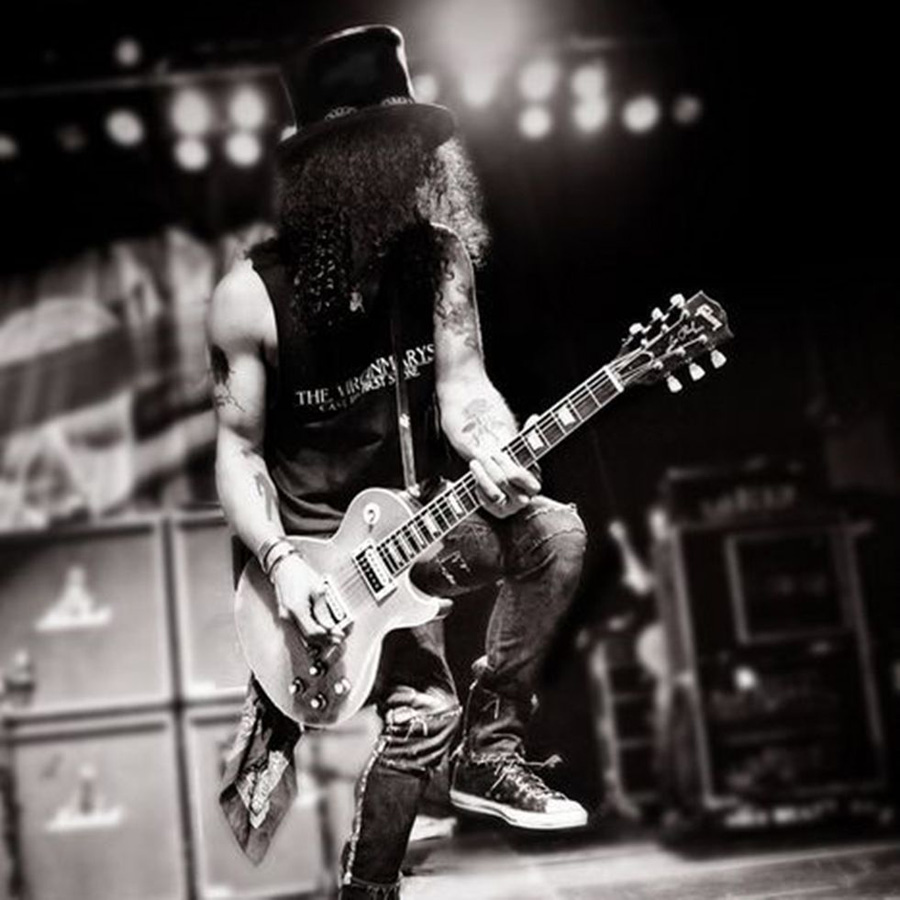
Slash – Gibson Les Paul
So what’s the result of the difference in components? Well, due to the quality of wood and electronics Epiphones generally lack the definition in sound of their more expensive stablemates. Many people cite a slightly woofier low end and less pronounced highs.
One of the main reasons people go for a Les Paul is for their resonance. As mentioned it’s a juicy sustain, a beautiful ring that you can even hear when the guitar is unplugged. Both Les Pauls shine here, it comes down to the solid wood and the inset neck and you could say that sustain is built into the design. In a lot cases, an Epiphone Les Paul will have more resonance than many guitars that are way more expensive, maybe just not a Gibson Les Paul.
The difference in thickness of wood, pickups and material, although may seem minor, all add up at the end of the day. But is it a $2000 difference? That’s your choice to make. Also consider that if you use a lot of pedals, or you don’t have a half-decent valve amp, the distinction will probably be a lot harder to pick.
As with most makes of guitar, there are numerous specifications of both Gibson and Epiphone Les Pauls and naming them all would be pointless and likely take all day. But here’s the gist. ‘Studio’ and ‘Special’, sit on the lower end, before the ‘Standard’ which is generally the benchmark model. ‘Custom’ models are variable, but often incorporate higher quality components. ‘Signature’ models are based on those played by famous artists and are often more expensive as a result.
Models like the Studio or LP-100 are great entry-level Epiphones and are pretty much made to be universally affordable. They’re good for beginners, who still want that high gain humbucker sound but their components aren’t as good as better models. You may notice cheaper looking finishes and higher action.
Epiphone’s more expensive models, such as the Les Paul Ultra III actually use a lot of very decent components and will always offer a price cut over a Gibson, making them pretty viable options for intermediate players.
Interestingly, you don’t have to part with $4000 for a Les Paul Standard to get a Gibson. There are options like the Studio Faded series and the Tribute line, which are still American- made, but are more affordable due to a few cost-cutting measures.

Marc Bolan – Gibson Les Paul
When it comes time to make the big decision, your verdict shouldn’t come down to the logo on the Gibson Les Paul headstock. If you know a friendly guitar shop owner with a lot of patience, play both (just don’t play Stairway to Heaven).
Can you notice the difference? Also, you’ve got to weigh up your skill level. Good music doesn’t sound good because the musicians used expensive gear, the expensive gear sounds good because it’s used by good musicians. A novice player won’t become a shredder just by forking out for a Gibson.
Also, you need to consider that not all Les Pauls are born equal. They’re made from wood, a natural material that will always have variations and imperfections, despite the quality checks performed by manufacturers. There’s dud Gibsons out there and you’ll find Epiphones that punch well above their weight, making them an awesome bargain.
Don’t ignore the second-hand market, but if you go down that route be sure to do your research so you don’t get low-quality year model, such as a patch of Gibsons in the ’70s.
Epiphones are great if you’re a beginner or a hobbyist, or if you just can’t justify the spend of the Gibson. Or maybe you already have a Gibson, but don’t want it getting damaged at gigs. A Gibson is the go if you’re a professional, or you’ve had an Epiphone for years and it’s time to upgrade. It could also be a good decision from an investment standpoint, or maybe you just scored an inheritance.
When it comes to picking an instrument, keep an open mind and don’t worry about the snobs and elitists. If you want something decent, but don’t want to fork out the price of a used Honda Civic, it’s worth looking at a few comparable models from each company. But if you’ve got the money to fork out for a Gibson, I’m sure you won’t regret the decision. Both instruments are great and there are strong points for both, so play a bunch and find the one that sings the sweetest to you.


